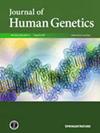假外显子激活的深层内含子变异和表型变异在一个中国肌营养不良症家庭。
IF 2.5
3区 生物学
Q2 GENETICS & HEREDITY
引用次数: 0
摘要
成熟mRNA中假外显子(PE)的异常包含是一种罕见的剪接缺陷,有助于杜氏肌营养不良(DMD)的发病机制。在这项研究中,我们描述了来自一个中国家庭的两名受影响的男性,他们表现为进行性肌肉无力,肌酸激酶(CK)水平升高,肌肉病理上出现营养不良变化。全基因组测序和基于链接的过滤在DMD基因47内含子(c.6913-4037T>G)中发现了一个共享的深层内含子变异,该变异激活了一个隐剪接位点,导致47和48外显子之间包含了一个72 bp的PE。患者诱导的多能干细胞(iPSCs)来源的肌管证实了这种PE的存在,与对照组相比,肌营养不良蛋白的表达显著降低。定量PCR显示,在肌管中,异常转录本占DMD转录本总量的89%,在肌肉中占97%,与肌营养不良蛋白几乎完全丧失相关。功能分析进一步显示肌管融合受损和钙信号改变。本研究强调了DMD内含子变异的诊断复杂性,并提供了支持c.6913-4037T b> G致病性的证据。本文章由计算机程序翻译,如有差异,请以英文原文为准。

Pseudoexon activating by a deep intronic variant and phenotype variation in a Chinese family with dystrophinopathy
Aberrant inclusion of pseudoexons (PE) in mature mRNA is a rare splicing defect contributing to Duchenne muscular dystrophy (DMD) pathogenesis. In this study, we described two affected males from a Chinese family who presented with progressive muscle weakness, elevated creatine kinase (CK) levels, and dystrophic changes on muscle pathology. Whole-genome sequencing followed by linkage-based filtering identified a shared deep intronic variant in intron 47 of DMD gene (c.6913-4037T>G), which activated a cryptic splice site and resulted in the inclusion of a 72 bp PE between exons 47 and 48. Patient induced pluripotent stem cells (iPSCs)-derived myotubes from the patient confirmed the presence of this PE, with a significant reduction in dystrophin expression compared to controls. Quantitative PCR revealed that aberrant transcripts comprised ~89% of total DMD transcripts in myotubes and ~97% in muscle, correlating with near-complete loss of dystrophin. Functional assays further showed impaired myotube fusion and altered calcium signaling. This study underscores the diagnostic complexity of intronic DMD variants and provides evidence supporting the pathogenicity of c.6913-4037T>G.
求助全文
通过发布文献求助,成功后即可免费获取论文全文。
去求助
来源期刊

Journal of Human Genetics
生物-遗传学
CiteScore
7.20
自引率
0.00%
发文量
101
审稿时长
4-8 weeks
期刊介绍:
The Journal of Human Genetics is an international journal publishing articles on human genetics, including medical genetics and human genome analysis. It covers all aspects of human genetics, including molecular genetics, clinical genetics, behavioral genetics, immunogenetics, pharmacogenomics, population genetics, functional genomics, epigenetics, genetic counseling and gene therapy.
Articles on the following areas are especially welcome: genetic factors of monogenic and complex disorders, genome-wide association studies, genetic epidemiology, cancer genetics, personal genomics, genotype-phenotype relationships and genome diversity.
 求助内容:
求助内容: 应助结果提醒方式:
应助结果提醒方式:


